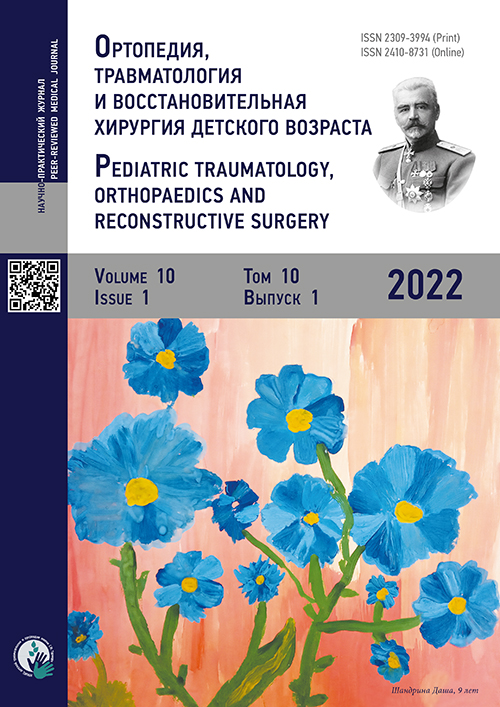Остеосинтез при изолированном переломе грудины у мальчика-спортсмена
- Авторы: Гаврилюк В.П.1, Костин С.В.1, Северинов Д.А.1, Машошина Л.О.1
-
Учреждения:
- Курский государственный медицинский университет
- Выпуск: Том 10, № 1 (2022)
- Страницы: 79-84
- Раздел: Клинические случаи
- Статья получена: 08.09.2021
- Статья одобрена: 20.01.2022
- Статья опубликована: 24.03.2022
- URL: https://journals.eco-vector.com/turner/article/view/79732
- DOI: https://doi.org/10.17816/PTORS79732
- ID: 79732
Цитировать
Аннотация
Обоснование. В настоящее время увеличивается количество пациентов детского возраста с травмами грудной клетки — около 12 % всех травм мирного времени. В первую очередь это связано с несоблюдением различных мер безопасности, ростом числа дорожно-транспортных происшествий.
Клиническое наблюдение. В данной статье представлено редкое клиническое наблюдение — перелом грудины со смещением отломков у мальчика 9 лет. В рассмотренном случае осуществляли открытую репозицию отломков с дальнейшей их фиксацией лавсановыми нитями.
Обсуждение. При лечении переломов грудины со смещением отломков могут быть использованы разные варианты остеосинтеза: накостный (пластиной и винтами), внутрикостный (остеосинтез спицами, гибкими титановыми стержнями), чрескостный (наложение серкляжного или лавсанового шва), внеочаговый (внешние фиксирующие устройства, оригинальные авторские конструкции). Описанный метод прост в исполнении и доступен практически каждому хирургическому или травматологическому стационару, оказывающему помощь детям.
Заключение. Одним из вариантов остеосинтеза при изолированных переломах грудины у детей до 10–12 лет является наложение лавсановых швов при открытой репозиции отломков. Важное преимущество описанного метода остеосинтеза состоит в малой травматичности и хорошем косметическом результате.
Ключевые слова
Полный текст
Об авторах
Василий Петрович Гаврилюк
Курский государственный медицинский университет
Email: wvas@mail.ru
ORCID iD: 0000-0003-4792-1862
SPIN-код: 2730-4515
Scopus Author ID: 57219595437
ResearcherId: H-2186-2013
д-р мед. наук, доцент
Россия, КурскСтанислав Витальевич Костин
Курский государственный медицинский университет
Email: drkostin@inbox.ru
ORCID iD: 0000-0003-0857-6437
SPIN-код: 7242-5368
канд. мед. наук, доцент
Россия, КурскДмитрий Андреевич Северинов
Курский государственный медицинский университет
Автор, ответственный за переписку.
Email: dmitriy.severinov.93@mail.ru
ORCID iD: 0000-0003-4460-1353
SPIN-код: 1966-0239
Scopus Author ID: 57192996740
ResearcherId: G-4584-2017
анд. мед. наук
Россия, КурскЛада Олеговна Машошина
Курский государственный медицинский университет
Email: lada-mashoshina@yandex.ru
ORCID iD: 0000-0002-4402-5723
студентка 4-го курса
Россия, КурскСписок литературы
- Дмитриев Р.В., Шинкарик И.Г., Рудакова Э.А. Закрытая травма груди у детей // Пермский медицинский журнал. 2011. Т. 28. № 6. С. 25–28.
- Корнеев И.А., Ахадов Т.А., Семёнова Н.А. и др. Мультиспиральная компьютерная томография в диагностике острой скелетной травмы у детей // Детская хирургия. 2018. Т. 22. № 6. С. 292–295. doi: 10.18821/1560-9510-2018-22-6-292-295
- Вагнер Е.А. Хирургия повреждений груди. Москва: Медицина, 1981.
- Bühlmann K.M., Castiglioni D.A., Flores X.O. et al. Clinical and radiological study of sternal fractures in paediatrics // Radiología (English Edition). 2019. Vol. 3. No. 61. P. 234–238. doi: 10.1016/j.rxeng.2019.03.010
- Rosenfeld E.H., Laua P., Shah S.R. et al. Sternal fractures in children: an analysis of the national trauma data bank // J. Pediatr. Surg. 2019. Vol. 5. No. 4. P. 980–983. doi: 10.1016/j.jpedsurg.2019.01.031
- Сатывалдаев М.Н., Аксельров М.А. Внешняя стабилизация грудного каркаса у детей при комплексном лечении тяжелой травмы грудной клетки: описание клинических случаев // Ортопедия, травматология и восстановительная хирургия детского возраста. 2018. Т. 6. № 2. С. 73–78. doi: 10.17816/PTORS6273-78
- Liman S. Chest injury due to blunt trauma // European Journal of Cardio-Thoracic Surgery. 2003. Vol. 23. No. 3. P. 374–378. doi: 10.1016/s1010-7940(02)00813-8
- Цеймах Е.А., Бомбизо В.А., Гонтарев И.Н. Миниинвазивные технологии в комплексном лечении больных политравмой с доминирующими повреждениями груди. Барнаул, 2013.
- Nishiumi N., Fujimori S., Katoh N. et al. Treatment with stabilization for anterior flail chest // Exp. Clin. Med. 2007. Vol. 32. No. 4. P. 126–130.
- Kiraly L., Schreiber M. Management of the crushed chest // Crit. Care Med. 2010. Vol. 38. P. 469–477. doi: 10.1097/CCM.0b013e3181ec6731
- Meinberg E.G., Agel J., Roberts C.S. et al. Fracture and dislocation classification compendium-2018 // J. Orthop. Trauma. 2018. Vol. 1. No. 32. P. 1–170. doi: 10.1097/BOT.0000000000001063
- Kouritas V.K., Zisis C., Vahlas K. et al. Isolated sternal fractures treated on an outpatient basis // Am. J. Emerg. Med. 2013. Vol. 31. P. 227–230. doi: 10.1016/j.ajem.2012.05.027
- Hsiao V., Santillanes G., Malek D., Claudius I. Review of interventions and radiation exposure from chest computed tomography in children with blunt trauma // J. Pediatr. 2018. Vol. 198. P. 220–225. doi: 10.1016/j.jpeds.2018.02.075
- Soysal Ö., Akdemir O.C., Ziyade S., Ugurlucan M. Management of sternal segment dislocation in a child with closed reduction // Case Rep. Med. 2012. Vol. 1–3. doi: 10.1155/2012/676873
- Sergio B.S., Daniel M.H., Gregor J.K., Frank-Martin H. Treatment of isolated sternal fracture with a vacuum bell in an 8-year-old boy // Interact. Cardiovasc. Thorac. Surg. 2018. Vol. 5. No. 26. P. 888–889. doi: 10.1093/icvts/ivx421
Дополнительные файлы

















